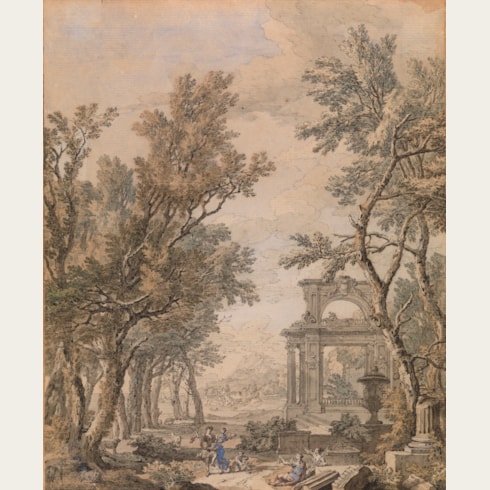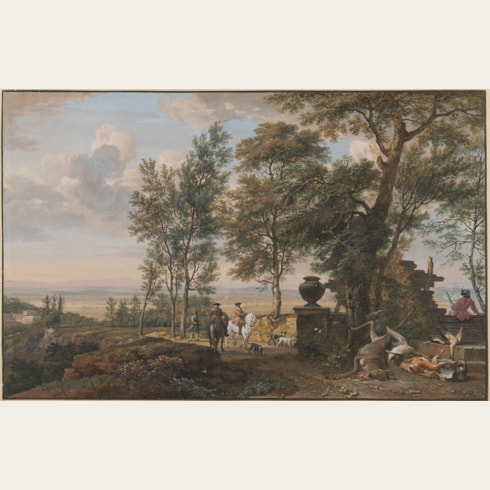Isaac de MOUCHERON
(Amsterdam 1667 - Amsterdam 1744)
Italianate Landscape with Peasants and Donkeys
Sold
Pen and grey ink and grey wash.
Signed and dated I. Moucheron Fecit 1712 at the lower centre.
Inscribed feitama and No 10 page 97. on the verso.
Further inscribed No. 45.a on the verso.
163 x 246 mm. (6 3/8 x 9 3/4 in.)
Signed and dated I. Moucheron Fecit 1712 at the lower centre.
Inscribed feitama and No 10 page 97. on the verso.
Further inscribed No. 45.a on the verso.
163 x 246 mm. (6 3/8 x 9 3/4 in.)
The composition of the present sheet, as noted in the 1758 Feitama sale catalogue, appears to be inspired by the Italianate landscapes of such earlier Dutch artists as Jan Both. Another signed and dated drawing of 1712 by Isaac de Moucheron, a scene of a deer hunt in a forest, is in the collection of the Noro Foundation, The Netherlands.
A painter, draughtsman and etcher, Isaac de Moucheron was the son and pupil of the landscape painter Frederick de Moucheron. While both father and son depicted much the same type of Italianate views, as the scholar Leo van Puyvelde noted of Isaac, ‘his work may be distinguished from that of his father by its loftier spirit and finer execution.’ Isaac de Moucheron was in Italy between 1695 and 1697, and on his return to Holland developed a successful career as a painter of large, decorative wall paintings for houses in Amsterdam. He made a particular speciality of Italianate landscapes, classical or Arcadian views and scenes of imaginary parks and formal gardens. In many of these decorative projects for private homes he worked in collaboration with the figure painter Jacob de Wit, while towards the end of the 1730s he also began to design the façades of buildings. Moucheron also painted a number of cabinet pictures of views of Roman and Italianate landscapes indebted to the examples of Claude and Gaspard Dughet. His success as an artist, and the popularity of his drawings and mural decorations, earned him an annual income of around 1,500 guilders.
In her catalogue raisonné of Isaac de Moucheron’s works, published in 1996, Nina Wedde noted of the artist that ‘The personal encounter with the Italian landscape and especially with the art of Gaspard Dughet radically changed his conception. In park landscapes Isaac also begins by discreetly introducing courtly elements in hunt scenes before turning his interest to formal garden layouts of a much more monumental nature, incorporating elements from Antiquity and from contemporary examples of design, people them with figures in tunics.’ As she further notes of Moucheron’s compositions, ‘The setting was further enhanced by the omnipresent tall, decorative trees with their finely detailed leafage ranging in the watercolours from the light ochre of the foreground to the deep green and blue tones of the distance. The backgrounds showed vistas over Southern harbours with shipping on the water and towerlike buildings on the rocky coastlines or of mountainous landscapes rising above undulating hills. The low-set horizon left ample space for a sky dappled with white clouds where birds smoothly sailed. Figures attired in classical dress animated the scenes. They are engaged in leisurely activities...Dogs are ever present companions while peacocks grace a few balustrades.’
As Wedde has also written of the artist, ‘The most complete and constant record of Isaac’s activity as an artist is preserved in the works on paper and his stature as a draughtsman of merit has seldom been contested.’ Moucheron produced finished drawings both in watercolour and in pen and ink; works which were much in demand by collectors. Subjects depicted include topographical views, Arcadian landscapes, scenes in the manner of earlier Dutch artists such as Nicolaes Berchem and, in particular, fantasy views of parks and gardens, known as 'hofgezichten'. At the time of Moucheron’s death some five hundred drawings remained in his studio and were dispersed at auction in December 1744, while many more must have been sold to collectors in his lifetime. Around four hundred drawings by the artist survive today, although only relatively few of these are signed or dated.
In her catalogue raisonné of Isaac de Moucheron’s works, published in 1996, Nina Wedde noted of the artist that ‘The personal encounter with the Italian landscape and especially with the art of Gaspard Dughet radically changed his conception. In park landscapes Isaac also begins by discreetly introducing courtly elements in hunt scenes before turning his interest to formal garden layouts of a much more monumental nature, incorporating elements from Antiquity and from contemporary examples of design, people them with figures in tunics.’ As she further notes of Moucheron’s compositions, ‘The setting was further enhanced by the omnipresent tall, decorative trees with their finely detailed leafage ranging in the watercolours from the light ochre of the foreground to the deep green and blue tones of the distance. The backgrounds showed vistas over Southern harbours with shipping on the water and towerlike buildings on the rocky coastlines or of mountainous landscapes rising above undulating hills. The low-set horizon left ample space for a sky dappled with white clouds where birds smoothly sailed. Figures attired in classical dress animated the scenes. They are engaged in leisurely activities...Dogs are ever present companions while peacocks grace a few balustrades.’
As Wedde has also written of the artist, ‘The most complete and constant record of Isaac’s activity as an artist is preserved in the works on paper and his stature as a draughtsman of merit has seldom been contested.’ Moucheron produced finished drawings both in watercolour and in pen and ink; works which were much in demand by collectors. Subjects depicted include topographical views, Arcadian landscapes, scenes in the manner of earlier Dutch artists such as Nicolaes Berchem and, in particular, fantasy views of parks and gardens, known as 'hofgezichten'. At the time of Moucheron’s death some five hundred drawings remained in his studio and were dispersed at auction in December 1744, while many more must have been sold to collectors in his lifetime. Around four hundred drawings by the artist survive today, although only relatively few of these are signed or dated.
Provenance
T. Smits(?)
Purchased from him in 1754 by Sybrand II Feitama, Amsterdam
His posthumous sale, Amsterdam, Bernardus de Bosch, 16 October 1758 onwards, Album (Kunstboek) K, lot 10 (‘Een Dito [Italiaansch Riviergezicht], in de manier van Both gestoffeerd, mede Ao.1712. h. 6 1/4, br. 9 1/2’), bt. together with lot 9, also by Moucheron, by Fouquet for 50 fl.
Pieter Fouquet, Amsterdam
Private collection, Germany.
Literature
Sybrand II Feitama, Notitie der Teekeningen…, MS inventory, 1746 onwards, p.34 (‘2 dito, overdwars, buiten Rome, ao 1712, gekocht ao 1754 bij T[…?] Smits(?)…50 -,’); Nina Wedde, Isaac de Moucheron (1667-1744): His Life and Works with a Catalogue Raisonné of his Drawings, Watercolours, Paintings and Etchings, Frankfurt, 1996, Vol.I, p.75; Michiel C. Plomp, ‘Robert Fucci, Drawn to Life: Master Drawings from the Age of Rembrandt in the Peck Collection at the Ackland Art Museum’ [book review], Master Drawings, Summer 2024, p.265, illustrated p.266, fig.2.







